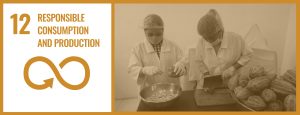2024 Research | SDG 2 – Zero Hunger
Research Programs
“From Orchard to Bottle: Exploring the Potential of Locally Available Fruits for Sustainable Wine Production and Indigenous Vegetables for Mixed Juice Drink”
Proponent: Honeylyn D. Farala
Abstract
Fruits and vegetable are recognized as fundamental source of nutrients. The research study was conducted to determine the acceptability, marketability and nutritive value of locally fruit wine and mixed juice drink. The 9-point hedonic scale and 7-point hedonic scale was used to determine the acceptability level of mixed juice drink of wines and 5-point Likert scale for marketability of the wine and juice. The analyzation results of one-way classification of the Analysis of variance (ANOVA) showed that pomelo wine has a grand weighted mean ranging from 6.68 to 6.80, The turnip wine 6.74 to 6.75, mango wine showed varied ratings in which food experts (grand weighted mean = 6.51) and community people (6.50) and FSM students (6.36). The pineapple wine, has grand weighted mean score ranging from 6.61 to 6.74. This indicates that all the wines are acceptable in three group of respondents. Lastly, for the pipino wine, it received the lowest rating in which it received a rating ranging from 5.99 to 6.36 categorized as only acceptable. For mixed juice drink receives very acceptable in terms of appearance, color, aroma, and taste and extremely acceptable in terms of texture. For the marketability of the study, it is revealed that it has very high potential in the market.
Optimization of Macaroons, Banana Cake, and Carrot Cake Recipes for Improved Quality and Consumer Acceptance
Proponents: Ma. Theresa R. Respicio, Macario Q. Tamundong Jr
Abstract
The study aimed to determine the acceptability of banana cake, carrot cake and macaroons. The experimental method of research was used with the survey questionnaire as the main data gathering instrument. The study used the nine-point Hedonic rating scale in evaluating the product’s acceptability in terms of appearance, color, aroma, taste and texture, in terms of nutritional content, the products were submitted to the Department of Science and Technology Region 3. Twenty (20) Food and Service Management students, twenty (20) food experts, and twenty (20) community people a total of sixty (60) were the respondentsof the study. The statistical tools used in the study were weighted mean and standard deviation. Results of the study revealed that the result shows that the Coconut Macaroons had the highest acceptability and with consistent rating across all the respondents, thus it indicates that the coconut macaroons have the potential to be a viable and appealing local product in the market. Meanwhile the acceptability of the banana cake was also very high which indicated that it could also be a dependable option. However, with regards to the carrot cake, refinement and adjustment are needed to meet community people’s preference while not affecting the positive perception of the FSM student and food experts. Further, all of the baked products nutrient composition reveals that the baked products have carbohydrates, protein, and total fat that were in lined in the standard percent of DailyValues in a 2,000-calorie diet. These indicates that the products were healthy to consumed by individuals. In the aspect of shelf-life, the products can indicate or include the exact expiration date or best before date on the packaging for the possible mass production and its market aspect.
“Innovative Approaches to Processed Meat Production: Improving Quality, Safety, and Sustainability”
Proponent: Mary Grace C. Buraga
Abstract
The study addresses the growing consumer awareness and negative perceptions surrounding processed foods by innovating healthier and more acceptable alternatives using locally sourced ingredients. Conducted in response to findings by the International Food Information Council, which indicated that 43% of primary grocery shoppers view processed foods unfavorably, this research focuses on developing innovative processed meats. Using banana stem as a natural flavor enhancer for longganisa and substituting traditional ingredients in tocino with pineapple wine and calamansi extract, the study employs a descriptive experimental method to evaluate product acceptability. Respondents, including food and service management faculty, community members, and food producers, assessed the products based on appearance, color, aroma, taste, and texture using a seven- point Hedonic rating scale. The analysis, using weighted mean, aims to identify nutritional content and determine shelf life. Results shows that the acceptability of innovative processed meats, specifically tocino and longganisa, using locally sourced ingredients to address consumer concerns about processed foods are well-received by the consumers. The sensory attributes of appearance, color, aroma, taste, and texture were assessed by three groups: FSM students, food experts, and community members. Tocino was highly rated across all sensory criteria,with community members giving the highest overall acceptability score (Grand Weighted Mean = 6.20). Longganisa also received positive ratings, particularly from FSM students (Grand Weighted Mean = 6.03), although food experts rated its appearance and texture as slightly acceptable. The study demonstrates that both tocino and longganisa are well-received by consumers, with potential for market success. The findings highlight the importance of natural flavor enhancements and minimal processing in meeting consumer expectations for healthier processed food options. This approach not only offers a sustainable model for food innovation but also supports local economies through the use of indigenous raw materials.
Acceptability of Slender Amaranth, Lemon Grass and Philippine lime as mixed juice drink
Proponent: Honelyn D. Farala
Abstract
This study evaluates the acceptability of three-juice drinks formulated from slender amaranth, lemongrass, and Philippine lime, focusing on sensory attributes such as appearance/color, aroma/odor, taste/flavor, and texture. Three different treatments were assessed by respondents using a 9-point hedonic scale. The results indicate high acceptability across all treatments, with mean scores ranging from 7.82 to 8.61, all falling within the “Like Very Much” category. Treatment 3 emerged as the most preferred
formulation, achieving the highest mean scores for appearance/color (M = 8.46), aroma/odor (M = 8.44), and texture (M = 8.61). One-way ANOVA revealed significant differences in taste/flavor (F = 5.830, p = 0.004) and texture (F = 4.254, p = 0.016), favoring Treatments 2 and 3 over Treatment 1. Post hoc analysis using Tukey’s multiple comparison test confirmed these differences, with Treatment 1 rated significantly lower in taste and texture compared to Treatments 2 and 3. The findings suggest that specific mixture ratios enhance sensory properties, particularly for Treatments 2 and 3. The high acceptability ratings indicate strong potential for these formulations as commercially viable products. Treatment 3 should be prioritized for further refinement and promotion as a premium offering within the market. The study provides valuable insights for product development and marketing strategies aimed at enhancing the appeal of functional beverages, ultimately contributing to their success in a competitive market.
“Nutritive Values of Slender Amaranth and Lemon Grass with Philippine Lime”
Proponent: Honelyn D. Farala
Abstract
The study aimed to determine the nutritive value and shelf life of slender amaranth, lemon grass and Philippine lime aqueous extract mixed juice drink. The product consisted
of three treatments, treatment 1 150 grams of slender amaranth, 100 grams of lemon grass and 200 grams Philippine line, treatment 2 100 grams of slender amaranth, 150 grams
lemon grass, 200 grams Philippine lime, and treatment 3 50 grams of slender amaranth, 200 grams of lemon grass, 200 grams Philippine lime. The nutritional value of the study
underwent a process and assessment conducted by the Department of Science and Technology (DOST) III and found out that there are ____________________________________________________. The study revealed that mixed juice drinks stored at room temperature have a longer shelf life. The study showed that the mixed juice drink has market potential.
“Marketability of Slender Amaranth and Lemon Grass with Philippine Lime”
Proponent: MACARIO Q. TAMUNDONG JR.
Abstract
The study aimed to determine the marketability of Slender Amaranth and Lemon Grass with Philippine Lime. The product consisted of slender amaranth, lemongrass, and
Philippine lime with different formulation. The descriptive – experimental method of research was used with the survey questionnaire as the main data gathering instrument. The
study used five-point Likert rating scale to evaluate the marketability. The statistical tools used in the study were weighted mean and ANOVA. The findings indicate that all
treatments are perceived positively across the respondent groups. However, there are no statistically significant differences in consumer demand, supply availability, or production
costs among the three treatments, as all p-values exceed the conventional threshold of 0.05. Lastly, the treatment 3 being the most favored formulation due to its higher mean scores across all evaluation criteria.
“A Taste of Paradise: Marketability of Coconut Curd (Latik) Macaroons”
Proponent: MACARIO Q. TAMUNDONG JR.
Abstract
The study aimed to determine the marketability of coconut curd macaroons. The product consisted of 250 grams,375 grams, and 500 grams proportions of coconut curd. The descriptive- experimental method of research was used with the survey questionnaire as the main data gathering instrument. The study used the five-point Likert rating scale in
evaluating the product’s marketability in terms of production cost, supply availability, and consumer demand. The respondents of the study were twenty (20) Food and Service Management students, twenty (20) food experts, and twenty (20) community people. The statistical tools used in the study were weighted mean and ANOVA. The findings revealed that the marketability of the coconut curd (latik) macaroons across different marketability criteria is strongly accepted by respondents. For consumer demand, result showed a statistically significant difference in the marketability of macaroons. However, in supply availability, result revealed a statistically no significant difference in the marketability of
macaroons. Lastly, production cost result displayed a small but significant difference in the marketability of macaroons. Thus, base from the result of this study the 375 grams shows a more consistent marketability profile therefore it was the most preferred measurement of coconut curd (latik) macaroons.
“A Taste of Passion: Acceptability of Coconut Curd (Latik) Macaroons”
Proponent: Ma. Theresa R. Respicio
Abstract
The study aimed to determine the acceptability of banana cake, carrot cake and macaroons. The experimental method of research was used with the survey questionnaire as the main data gathering instrument. The study used the nine-point Hedonic rating scale in evaluating the product’s acceptability in terms of appearance, color, aroma, taste and texture. Twenty (20) Food and Service Management students, twenty (20) food experts, and twenty (20) community people a total of sixty (60) were the respondents of the study. The statistical tools used in the study were weighted mean and standard deviation. Results of the study revealed that the Macaroons had the highest acceptability and with consistent rating across all the respondents, thus it indicates that the coconut macaroons have the potential to be a viable and appealing local product in the market. Meanwhile the acceptability of the banana cake was also very high which indicated that it could also be a dependable option. However, with regards to the carrot cake, refinement and adjustment are needed to meet community people’s preference while not affecting the positive perception of the FSM student and food experts. In the aspect of nutritional content, all baked products
“A Bite of Goodness: Nutritive Values and Shelf Life of Coconut Curd (Latik) Macaroons”
Proponents: MACARIO Q. TAMUNDONG JR., Honeylyn D. Farala
Abstract
The study aimed to determine the nutritive value and shelf life of coconut curd (latik) macaroons. The product consisted of 250 grams, 375 grams and 500 grams proportions of macaroons with coconut curd. The nutritional value of the study underwent a process and assessment conducted by the Department of Science and Technology (DOST) III and found out that there are ____________________________________________________. The study revealed that mixed juice drinks stored at room temperature have a longer shelf life. The study showed that coconut curd macaroons are acceptable and have market potential.
Capturing the Most Significant Changes From College Extension Projects of ISU Cabagan through Clients’ Narratives
Proponents: Rosalinda S. Guingab, DComm; Myrna C. Cureg, PhD; Regina Blair S. Santiago, MSDC
Study 1: Identification and Screening of College Extension Projects
Study 2: Stories of Most Significant Changes from Mabuwaya-Funded Extension Projects
Study 3: Development of IEC Materials Featuring the Most Significant Stories of Change from the College Extension Projects of ISU Cabagan
Abstract
Using the Most Significant Change (MSC) as its framework, this research documents community perspectives on the Save Our Species extension project’s socio-cultural and economic impacts. Key themes include changes in perceptions toward the Philippine crocodile, increased community participation in conservation, cultural and economic effects of conservation, empowerment of indigenous communities, establishment of the roles of local sanctuary guards, and provision of other livelihood opportunities. The findings offer insights into how Communication, Education, and Public Awareness (CEPA) activities on conservation, as part of an extension project, can foster sustainable development and provide guidance for future initiatives aimed at ensuring the long-term preservation of endangered species.
Respone of High Yielding Open-Pollinated Variety (OPV) Yellow Corn (Zea mays L.) to Leaf Removal and Application of Varying Amounts of Gibberelic Acid
Proponents: Jayson C. Atal, Marina B. Laman
Abstract
Corn is the second most significant crop in the Philippines. However, Its productivity and sustainability were not fully optimized. To explore its potential, the field stidy on the response of Open Pollinated Variety Yellow Corn on Defoliation and Varied amounts of giberrelic acid was conducted at Baranggay,Union, Cabagan, Isabela. The experiment was laid out in a Randomized Complete Block Design (RCBD) with three replication with leaf defoliation as factor A treatment which consisted of no defoliation (A1) and three leaves defoliated above the ear (A2), and three leaves defoliated below the ear (A3) and amount of giberellic acid as factor B which consisted of no GA3 (B1), 300ppm (B2), 350ppm (B3) and 400ppm (B4). The OPV Yellow corn subjected to leaf defoliation and application of varried amounts of GA3 revealed a comparable effect on plant height diameter and weight of dehusked ears, statlk diameter and yield per hectare.. However, no defoliation recorded the longest dehusked ears (167.78mm), and heaviest biomass weight (497.66kg) while application of 350 ppm GA3 gained the heaviest weight of 1000 grains per plot (241.66g). Moreover, defoliation below the ear with application of 400ppm and 350ppm gained the highest net income (Php. 46,368.00), (Php.51,096.00) and return of investment (76.76%), (83.78%)respectively. It is then recommended that defoliation below the ear together with the application of GA3 at 400ppm be adopted to promote productively at humid environment.
Comparative Analysis of the Profitability of Small-Scale Monoculture and Diversified Yellow Corn Production Farms in Cabagan, Isabela
Proponents: Michelle Ann M. Calubaquib,Ph.D
Abstract
The study aimed to compare the profitability of small-scale monoculture and diversified yellow corn production farms in Cabagan, Isabela. It sought to characterize the socio- demographic profile of farmers, compare their farming practices, and determine profitability. The research was conducted through house-to -house survey of 30 farmers engaged in monoculture and 30 farmers practicing diversified farming. The findings revealed that oldr farmers predominantly practice both farming systems, with monoculture farming involving more male farmers (70%) and diversified farming having a higher proportion of female farmers (60%). Most farmers in both systems are married and have educational background ranging from elementary to high school levels. Income levels are generally low, with diversified farming showing a broader income distribution. In term of cultural management practices, monoculture farmers rely more on tractors (80%), mechanical seeders (75%), and herbicides (90%), ehile diversified farmers prefer traditional methods such as manual planting (65%), and araro (plowing)(60%). Monoculture farming incurs higher cash cost due to greater dependenceon fertilizers and labor, leading to potential soil degradation .In contrast, diversified farming employs a variety of water sources and integrates more manual labor in seed preparation, planting, and water management, resulting in lower input costs. The gross profit margin ratio for monoculture farming is 0.82, meaning they retain 0.82 centavos per every peso of income after covering the cost of goods sold, compared to 0.67 centavos for diversified farmers. Monoculture farming offers higher immediate profit margins but demands more input and is more susceptible to soil degradation and pest issues. Diversified farming, while yielding lower profit margins, provides sustatinability benefits through reduced input cost and labor savings.
Development of Sesame Based-Product in Cabagan, Isabela
Proponents: VILMA U. ATALIN, DR. SAMUEL R. SIMON, MR. JONATHAN S. BALOG, MS. KRISTINA MANALIGOD, MR. JOHN PAOLO N. FAUSTINO, MS. MARIA SABRINA B. ESTAVILLO
Abstract
Sesame (Sesamum indicum L.) seeds has been utilized mostly for oil processing and often as added ingredients for savory dishes or toppings of baked bread & biscuits. This study aimed to innovate food products based from sesame seeds in order to introduce and promote the utilization & increase consumption of this highly acclaimed nutritious seed. Various trial-and-error processing was conducted specifically the ratio of ingredients as well as the variety (Black or Brown variety) better suited for each product being developed. After the rigorous trials, four products were developed which are: butter, brittle, and polvoron. Through passing the microbial tests at Department of Science & Technology- Regional Standards and Testing Laboratory (DOST-RSTL), the products underwent single-blind sensory evaluation with seventy-five (75) respondents coming from various locations, gender, and age. The nine (9) hedonic scale were used as tool in sensory evaluation to assess and measure the likability or consumer preference for food products as to aroma, texture, smell, and taste. Results showed that for Sesame Butter, the Brown variety exceeded other variants by gaining highest percentage overall acceptance with 32.3% of respondents rated like extremely and 29.00% like very much. For the Sesame brittle, since the Black variety of sesame did not pass the microbial tests only the Brown variety was compared to the control (commercially available product) and this resulted with overall acceptance of the Control higher than the Brown Sesame variety but it can be noted that the Brown sesame brittle obtained higher rating for texture (32.00%) and equal rating for aroma (34,67%). The scenario for Sesame polvoron is that, Brown variety of sesame did not pass the microbial tests that is why only Black variety is compared to the Control wherein the latter consistently surpassed the black sesame polvoron in all areas of evaluation. Though various food products can be developed and innovated for sesame seeds, the results inferred that the acceptance of sesame (Black & Brown variety) is widely influenced by the appearance of the product.
“Morphological Characterization of F2 Interspecific Peanut (Arachis hypogaea L.x Arachis pintoi) Lines in Support to Breeding Population Development in Cabagan, Isabela”
Proponents: Vilma U. Atalin, John Paolo N. Faustino
Abstract
The study was conducted to characterize the four F2 interspecific peanut lines (Arachis hypogaea L. x Arachis pintoi) and their respective maternal peanut cultivars. The genetic
composition of peanut cultivars and wild relatives as potential source of valuable variations in crop improvement programs and introgression of traits from peanut wild relatives. Morphological characterization was conducted during 2023 wet season under Type II climatic conditions. The treatments used were the F2 interspecific peanut lines Pn22-7-a, Pn22-1-a, Pn22-2-a, and Pn22-5-a and also Gamu Pn, BPI Pn9, NSIC Pn11 and NSIC Pn18 which serves as check maternal peanut cultivars. Experimental lines were grown in experimental plots following the Randomized Complete Block Design and characterized using the revised characterization form. Data were analyzed using STAR software version 2.0.1.2014 following procedures of multivariate analysis through agglomerative cluster analysis. Eight experimental lines were grouped into three main clusters based on similarities in phenotypic and morphological characteristics. These clusters provide information on variable groupings that can be used for future breeding and conservation activities. The lower the coefficient of dissimilarity, the more detailed the cluster grouping can be formed. Cluster 1 and Cluster 3 were both composed of 3 entries each and Cluster 2 with 2 entries.
DEVELOPMENT OF PRODUCTION PROTOCOLS FOR LOCAL SESAME VARIETIES IN CABAGAN, ISABELA
Proponents: Vilma U. Atalin, Jonathan S. Balog, John Paolo N. Faustino
Abstract
This study explored the growth and yield performance of sesame (Sesamum indicum) under varying fertilizer treatments across two seasons (Wet Season and Dry Season of 2022-2023). Results from the Wet Season trials showed that for Factor A, FT2 (RR + 10 bags organic fertilizer (OF)/ha.) achieved the highest seed yield per hectare (352.58 kg/ha), followed by FT4 (303.28 kg/ha). For Factor B, Black Sesame (V2) outperformed the other variety with a significantly higher mean seed yield of 321 kg/ha compared to 281 kg/ha (V1). Fertilizer rates had no significant effect on plant height, but Brown Sesame (V1) produced taller plants (168.25 cm). As to the number of capsules per plant, FT2 remained ahead of other treatment as well as the highest seed count per capsule. In the Dry Season, the same trend was observed, with FT2 yielding the highest seed yield (200.67 kg/ha) and the tallest plants (173.72 cm). Fertilizer rates significantly impacted capsule and seed counts, with FT2 consistently leading in both metrics across both sesame varieties. This study further highlights the positive impact of organic fertilizer supplementation on sesame growth and yield, particularly when used at 100% of the recommended rate (10 bags per hectare).
Development and Kiwit Fish (Asian Swamp Eel) as Delicacy
Proponent: Glorilyn B. Alejandro
Abstract
The main objective of study was to develop delicacies from “Kiwit” or Asian swamp eel meat. Specifically, it aimed to determine the requirements and processes in making the following Asian swamp eel food products. The study also determined the level of acceptability of the developed food products in terms of appearance, taste and flavour as perceived by its respondents. The food product development began with the preparation of the Asian swamp eel. Dressing the eel fish includes salting, removal of head and tail, washing with running water, removal of entrails, skin removal, and deboning. After the first stage of preparation, the process of food product development comes next. The developed food products were rated as highly acceptable by the respondents in terms of appearance, taste and flavour. In conclusion, the processed Asian swamp eel meat and skin can be developed into acceptable food products. The food products can be enhanced by adding other organic ingredients like herbs and seasonings to further improve its taste and aroma.
Development of Instant Sinigang Mix from Lubeg (Syzygiumlineatum (Roxb) Merr & Perry) Fruits
Proponent: Evelyn B. Cristobal, EdD
Abstract
This study aimed to develop and evaluate an instant sinigang mix powder made from lubeg fruits. The objectives were to assess its acceptability as a seasoning in sinigang dishes (in terms of appearance, aroma, taste, and overall acceptability), identify the most accepted recipe among fish, pork, and beef sinigang, and conduct a cost-return analysis. Results showed high acceptability across all recipes, with fish (M=4.73, SD=0.28), pork (M=4.70, SD=0.28), and beef (M=4.67, SD=0.34) scoring well in general acceptability. Differences in appearance (F=5.491, p<0.05) and taste (F=3.782, p<0.05) were noted, although aroma and general acceptability showed no significant variation, suggesting consistent quality across recipes. These findings align with previous studies on natural souring agents, which also showed favorable ratings across quality attributes. The cost-return analysis indicated a production cost of P82.00 and a selling price of P128.00, yielding a profit of P46.00 and a 56% return on investment. This underscores the potential of using local ingredients like lubeg for sustainable product development, supporting local economies and enhancing the viability of small enterprises. The instant sinigang mix powder from lubeg offers a commercially viable and locally sustainable option for flavor enhancement in Filipino cuisine.
Growth Performance and Sensory Evaluation of Sasso Chicken Supplemented With Different Commercial Probiotics
Proponent: Lilibeth S. Languido, PhD
Abstract
The study was conducted to determine the effects of different probiotics on the growth, sensory, and histopathological characteristics of Sasso chicken reared in a complete confinement type of housing for 77 days at Sta. Filomena, San Mariano, Isabela. A total of 150 straight-run Sasso chicks were involved in this study and were randomly distributed to four (4) treatments with three replications, with different probiotics namely Brand W, Brand X, Brand Y, Brand Z, and pure water as control. The experiment was laid out using a Completely Randomized Design (CRD) with three replications. Based on the results of the study, the supplementation of the different probiotics on the growth performance of Sasso chicken showed no significant improvement in terms of weight gain, feed conversion and efficiency, weekly feed, and water consumption among the broiler chickens. However, a significant result was obtained on the 9th weekly rate of growth of the Sasso which was supplemented with different probiotics. On the other hand, no significant variation was observed in the dressing percentage with and without giblets, giblets weight, and cut-up parts. Also, the result of the sensory evaluation shows significant results on general appearance, aroma, flavor, juiciness, and tenderness. No significant difference was obtained in the intestinal segments (duodenum, jejunum, and ileum), villi height, villi width, and crypt depth. The inclusion of Brand W improved the quality and taste of the colored broiler, hence this is recommended. However, more research is necessary to include antibiotic residue tests and proximate analysis of the chicken meat supplemented with probiotics to obtain more conclusive results.
Enhancing the Basic Services on the Implementation of Sustainable Development Goals: The Municipality of San Mateo Case
Proponent: Rosalie C. Leal, and Venus A. Diego
Abstract
The paper examines the role of Local Government Units (LGUs) in providing quality basic services in accordance with the United Nations’ Sustainable Development Goals (SDGs), specifically in the municipality of San Mateo, Isabela. The study seeks to confirm their accomplishments by evaluating the execution of fundamental services in accordance with the Sustainable Development Goals (SDGs). It concentrates on certain Sustainable Development Goals associated with agriculture, infrastructure, health, environmental management, tourism, education, and social services, highlighting the interaction between political and governance frameworks.
The study evaluates fundamental services, the integration of Sustainable Development Goals (SDGs), levels of satisfaction, and disparities among respondent groups, while proposing improvement initiatives. Results indicate significant integration and favorable evaluations, demonstrating a dedication to global sustainability. San Mateo’s distinguished status and multiple accolades highlight its dedication to the Sustainable Development Goals (SDGs). This research concludes that San Mateo delivers services equally, emphasizing inclusivity and equality. The affirmative association between integration and satisfaction underscores the significance of aligning services with sustainable development concepts. Recommendations encompass ongoing enhancement, needs assessments, periodic evaluations, community satisfaction surveys, adaptive action plans, and a specialized monitoring division. The study adds to what is known about sustainable development in local government by showing how integration, satisfaction, and the success of implementing the SDGs in LGU San Mateo are all connected.

















